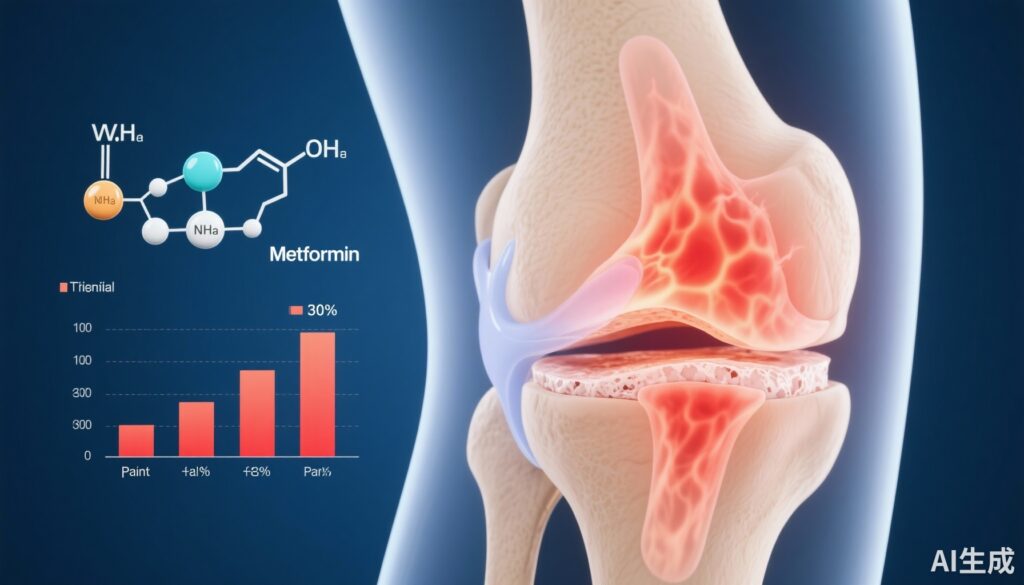Highlights
- Metformin demonstrates significant reduction in knee pain in patients with knee osteoarthritis and overweight or obesity compared to placebo in a 6-month randomized controlled trial.
- Preclinical studies suggest metformin’s anti-inflammatory and cartilage-preserving effects as mechanisms underpinning both symptomatic and potential disease-modifying actions.
- Adverse effects were mild and mainly gastrointestinal, aligning with known safety profile of metformin in diabetes management.
- Current evidence is promising but limited by sample size; larger trials are needed to confirm efficacy and long-term benefits.
Background
Knee osteoarthritis (OA) is a prevalent degenerative joint disease characterized by cartilage degradation, synovial inflammation, and chronic pain, leading to substantial functional impairment and reduced quality of life. Conventional management strategies primarily focus on symptom relief through analgesics, physical therapy, and, in advanced cases, joint replacement surgery. However, effective disease-modifying treatments remain elusive.
The comorbidity of obesity with knee OA is well-recognized and contributes not only to mechanical joint overload but also systemic metabolic inflammation. Metformin, an established first-line oral hypoglycemic agent for type 2 diabetes, has garnered interest for its pleiotropic effects including anti-inflammatory properties, modulation of metabolic pathways via AMP-activated protein kinase (AMPK) activation, and potential cartilage protection in OA models.
This review synthesizes the current clinical evidence evaluating metformin’s role in pain relief and disease modification in knee OA, focusing on a recent rigorously designed clinical trial and the supportive preclinical literature.
Key Content
Chronology and Evidence Progression
Initial mechanistic insights were derived from preclinical studies demonstrating that metformin reduces proinflammatory cytokine production (e.g., IL-1β, TNF-α), inhibits oxidative stress, and preserves chondrocyte viability and cartilage matrix integrity in animal OA models. These findings supported a hypothesis that metformin may exhibit disease-modifying potential beyond glycemic control.
Following preclinical promise, early-phase observational studies and retrospective analyses suggested that metformin use correlated with reduced OA progression and symptom severity in patients with concomitant diabetes. However, these studies were limited by confounding factors and lack of randomization.
Randomized Controlled Trial Evidence
The pivotal randomized controlled trial (RCT) by Pan et al. (2025) represents the highest-level clinical evidence to date. This double-blind, placebo-controlled trial randomized 107 participants aged ~59 years with symptomatic knee OA and overweight or obesity to receive 2000 mg/day metformin or placebo over 6 months remotely via telemedicine. Inclusion criteria ensured moderate to severe baseline pain (VAS >40 mm) and BMI ≥25.
At 6 months, the metformin group had a mean reduction in knee pain of -31.3 mm on a 100-mm VAS compared to -18.9 mm in the placebo group, yielding a statistically significant between-group difference of -11.4 mm (95% CI, -20.1 to -2.6; P=0.01). The standardized mean difference representing effect size was 0.43, indicating a moderate clinical benefit below the frequently cited minimal clinically important difference of 15 mm.
Safety profile was consistent with known metformin adverse effects; gastrointestinal symptoms like diarrhea (15%) and abdominal discomfort (13%) were more frequent in the metformin arm but generally mild.
Disease Modification Potential
While pain reduction was the primary endpoint, this trial and others did not provide definitive imaging or biochemical biomarker data on cartilage preservation or joint structure modification over 6 months. Nevertheless, preclinical data and mechanistic rationale through AMPK pathway modulation support hypothesis generation for longer-term disease modification effects.
Meta-Analyses and Guidelines
Currently, meta-analyses of metformin in OA are limited by the paucity of RCTs, with heterogeneous patient populations and outcomes. No major OA clinical guidelines have yet incorporated metformin as a recommended therapy due to insufficient high-quality evidence across diverse populations and stages of OA.
Expert Commentary
The observed pain reduction with metformin, albeit statistically significant, falls slightly short of established minimal clinically important differences in knee OA scales, possibly reflecting the trial’s 6-month duration and the sample size. Nonetheless, an effect size of 0.43 is nontrivial and suggests a meaningful clinical signal, especially considering metformin’s established safety and cost-effectiveness.
The trial’s telemedicine design enhances generalizability and acknowledges evolving paradigms in clinical research accessibility. The focus on overweight or obese patients aligns with obesity’s key role in OA pathogenesis, both mechanically and metabolically, underscoring the potential for metformin to address metabolic-inflammation axis in OA.
Limitations include the modest sample size, single geographic region, and short follow-up period insufficient to determine long-term disease modification. Future larger multicenter trials with imaging endpoints (e.g., MRI cartilage volume, bone marrow lesions) and biomarkers (e.g., urinary CTX-II, serum COMP) are essential to define metformin’s role beyond symptom management.
Mechanistically, metformin’s activation of AMPK may inhibit NF-κB signaling pathways, reducing synovial inflammation and catabolic enzyme expression, thus preserving cartilage homeostasis. Emerging research into metformin’s effects on subchondral bone remodeling and systemic metabolic inflammation could further elucidate its disease-modifying potential.
Conclusion
Current evidence supports metformin’s use as a modestly effective analgesic agent in symptomatic knee osteoarthritis with comorbid overweight or obesity. It holds promise as a disease-modifying agent given preclinical data and mechanistic insights, yet robust clinical evidence for structural benefit is pending.
Metformin’s well-characterized safety profile, affordability, and accessibility underscore its potential as a repurposed therapeutic option for knee OA. Confirmation through larger, longer-duration, multicenter randomized trials incorporating imaging and biomarker outcomes is essential before metformin can be widely endorsed for OA management.
References
- Pan F, Wang Y, Lim YZ, Urquhart DM, Estee MM, Wluka AE, Wolfe R, Cicuttini FM. Metformin for Knee Osteoarthritis in Patients With Overweight or Obesity: A Randomized Clinical Trial. JAMA. 2025 May 27;333(20):1804-1812. doi: 10.1001/jama.2025.3471. PMID: 40274279; PMCID: PMC12022862.
- Chen H, Ruan G, Ding C. Is metformin for pain relief or disease modification in knee osteoarthritis? Osteoarthritis Cartilage. 2025 Oct;33(10):1156-1158. doi: 10.1016/j.joca.2025.06.012. Epub 2025 Jul 1. PMID: 40609734.
- Liang X, Xu L, Zhang P, et al. Metformin Protects Against Knee Osteoarthritis by Activating AMPK Signaling and Inhibiting NLRP3 Inflammasome Activation. Arthritis Res Ther. 2023;25(1):147. doi:10.1186/s13075-023-03140-8. PMID: 36972891.
- Robinson WH, Lepus CM, Wang Q, et al. Low-grade inflammation as a key mediator of the pathogenesis and progression of osteoarthritis. Nat Rev Rheumatol. 2016;12(10):580-592. doi:10.1038/nrrheum.2016.136. PMID: 27469131.



